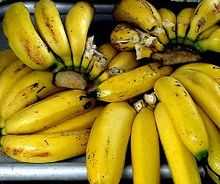Gros Michel banana
| Musa acuminata 'Gros Michel' | |
|---|---|
 Gros Michel bananas from Jamaica. | |
| Details | |
| Species | Musa acuminata |
| Cultivar group | AAA Group |
| Cultivar | 'Gros Michel' |
| Origin | Martinique, Jamaica[1] |
Gros Michel, often known as Big Mike, is an export cultivar of banana and was, until the 1950s, the main variety exported to the United States.[2]
Taxonomy
Gros Michel is a triploid cultivar of the wild banana Musa acuminata, belonging to the AAA group.[3]
Its official designation is Musa acuminata (AAA Group) 'Gros Michel'.
Synonyms include:
- Musa acuminata L. cv. 'Gros Michel'
- Musa × paradisiaca L. cv. 'Gros Michel'
Gros Michel is known as Guineo Gigante, Banano, and Plátano Roatán in Spanish. It is also known as Pisang Ambon in Malaysia, Pisang Embung in Indonesia, Thihmwe in Burma, and Kluai hom thong in Thailand.[3]
Description
The 1923 musical hit "Yes, We Have No Bananas" is said to have been inspired by a shortage of the "Big Mike" bananas, which began with the infestation of Panama disease early in the 20th century.[4]
By 1960, the major importers of Gros Michel bananas were nearly bankrupt, and had waited until the last minute to deal with the financial and environmental crisis. The Cavendish had to be cultivated so consumers would still be able to obtain bananas.[2]
The Honduras Foundation for Agricultural Research cultivates several varieties of the Gros Michel. They have succeeded in producing a few seeds by hand-pollinating the flowers with pollen from diploid, seeded bananas.[5]
The international name of this banana variety is ‘Gros Michel’ (Musa acuminata AAA). This variety was once the dominant export banana to Europe and North America, grown in South America and Africa. In the 1950s the Panama disease, a wilt caused by the fungus Fusarium oxysporum, wiped out vast tracts of ‘Gros Michel’ plantations in South America and Africa, but the cultivar survived in Thailand. The original 'Gros Michel' is said to have a unique fragrance.[citation needed]
After the banana catastrophe, South American and African plantations switched to the resistant Cavendish banana subgroup (another Musa acuminata AAA). The clone ‘Dwarf Cavendish’, today’s food banana in the west, has a different flavour, a different morphology (‘Gros Michel’ is slimmer) and unlike ‘Gros Michel’ they do not turn fully yellow in tropical lowlands. If we compare the plants, a ‘Gros Michel’ can reach seven meters, while a ‘Dwarf Cavendish’ only reaches the height of a human. A Malaysian variety within the Cavendish subgroup sometimes found in Thailand is ‘Gluay hom kiao’.
The original 'Gros Michel' variety is a top export for producing countries in Malaysia and Thailand, with the grade A bananas being exported to Japan, and increasingly to China.[citation needed]
See also
- Banana
- Banana cultivar groups
- Cavendish banana
- Grand Nain (Chiquita banana)
- Musa acuminata
- Banana breeding impeded by triploidy
References
- ↑ Robert J. Lancashire (25 August 2006). "Jamaican bananas and plantains". The Department of Chemistry, University of the West Indies. Retrieved 11 January 2011.
- ↑ 2.0 2.1 Koeppel, Dan (2008-06-18). "Yes, We Will Have No Bananas" (Editorial). New York Times. Retrieved 2008-06-18.
- ↑ 3.0 3.1 Michel H. Porcher; Prof. Snow Barlow (2002-07-19). "Sorting Musa names". The University of Melbourne, . Retrieved 11 January 2011.
- ↑ Koeppel, Dan (19 June 2005). "Can This Fruit Be Saved?". Popsci.com. Retrieved 2008-06-22.
- ↑ Carla Helfferich (1990). "Battling for Bananas". Alaska Science Forum. Retrieved 2008-06-02.
External links
| |||||||||||||
| |||||||||||||||||||||||||||||||||||||||